In the ancient land of Australia, a rich artistic tradition began – Aboriginal dot painting. This art form comes from deep-rooted traditions in rock, bark, and body art. It holds the cultural, spiritual, and political views of Aboriginal people. It represents their strong connection to the land and Dreamtime stories.
For thousands of years, Aboriginal artists have told stories through various mediums. Evidence of their ancient art can be seen at the Walinynga archaeological site, with some parts over 24,000 years old1. Over time, the art evolved. In 1994, Emily Kame Kngwarreye’s painting “Earth’s Creation” wowed the Venice Biennale. It was later sold for a high $2.1 million. This shows the value of Aboriginal dot paintings in the art world today1.
Unbox your creativity, From Beginner to Master: We Have You Covered
Key Takeaways:
- Aboriginal dot painting is a contemporary artistic expression rooted in ancestral traditions. (Aboriginal dot painting, indigenous art)
- It represents a deep spiritual connection to the land and Dreamtime stories, showcasing the cultural and symbolic richness of Aboriginal culture. (aboriginal culture, traditional australian art)
- The oldest parts of Aboriginal art can be traced back thousands of years, highlighting its enduring presence in Indigenous Australian society. (aboriginal art, traditional aboriginal art)1
- The emergence of dot painting in contemporary Aboriginal art is often credited to the efforts of a schoolteacher named Geoffrey Bardon in the 1970s. He introduced dot painting to a wider audience1.
- Aboriginal dot painting has evolved from traditional mediums to modern ones like canvas and board. This change has helped the art form to grow and thrive today. (dot painting techniques)
- The global appreciation of Aboriginal dot paintings has helped art centers in Aboriginal communities. These centers are hubs for cultural preservation and economic development. They provide a sustainable living for Indigenous artists. (aboriginal dot painting, australian indigenous artists)1
The Origins of Aboriginal Dot Painting
Aboriginal dot painting comes from an ancient art tradition. It is deeply linked to Aboriginal culture’s storytelling heritage. People used dot painting to pass down knowledge through visual art forms.
This method of painting with dots has its roots in the Aboriginal people’s sand drawings. These were done long ago. The paintings were more than just decoration. They were tools for teaching, spiritual guidance, and sharing traditions.
About 40 years ago, in 1971, dot painting began its journey2. It marks a more recent phase in Aboriginal art. Before, Aboriginals used nature’s materials for their art, like rocks and flowers.
With acrylic paints, a new era in art began. The artists could now use varied colors for their pieces2. The artworks might show dots, lines, spirals, and more. Through these designs, the Western Desert Aboriginal People tell deep and fascinating stories.
The dot technique makes Aboriginal art look almost 3D2. This adds movement and life to the artwork. The Aboriginal artists used dots to keep the true meanings hidden from outsiders and some other Aboriginal groups2.
The 1970s brought the start of the Papunya Tula Art Movement. This was a big turning point for dot painting. Artists moved from painting on cardboard to canvas2. This change allowed for more detailed and durable artworks.
At first, these paintings showed everyday objects and rituals. Later, they turned into the dot paintings we know today2.
Today, many people see dot painting as the main form of Aboriginal art across Australia3. But, there’s more to Aboriginal art than just dots. Aboriginal artists are always trying new techniques and styles. They remain at the forefront of creative art in Australia3.
In summary, Aboriginal dot painting is a rich part of Aboriginal culture. It started as a way to tell stories using dots. Now, it’s a symbol of strength and creativity in Indigenous Australian culture.
Unbox your creativity, From Beginner to Master: We Have You Covered
Symbolism in Aboriginal Dot Painting
The symbols in Aboriginal dot paintings tell stories. They are more than just pretty pictures. Each dot and figure represents something significant from Aboriginal culture. This includes their stories of creation, values, and sacred sites. This way, a painting becomes a map of cultural knowledge, linking people to their past and beliefs.2
Art as a Cultural Pillar
Aboriginal dot painting is key in their culture, showing their history and spiritual beliefs. It’s a way to tell stories and share knowledge, connecting past and present. These paintings are filled with meaning, which is only fully understood by some.
Dot paintings are more than just art; they show the spiritual and traditional laws of the Aboriginal people. These paintings carry stories that express their culture, linking reality to the Dreamtime. This art helps us understand their heritage and appreciate their history and beliefs.1
“The symbolic power of Aboriginal dot painting lies in the seamless connection it creates between the people, the land, and their ancestors. Each dot, line, and shape tells a story, serving as a visual language capable of transmitting law, social values, and spiritual beliefs.”
Aboriginal art, especially dot painting, has been vital for keeping their culture alive. It’s like a pillar, holding their ancestors’ wisdom and knowledge. These artworks remind the people of the importance of respecting the land and their way of community living.4
Art is the heart of the Aboriginal culture, enhancing its survival. Things like songs, dances, and rituals play a big part in their traditions. They help pass cultural practices to new generations. Language also plays a huge role, linking them to their ancestors and their beliefs.4
“Dot painting, with its symbolic language and ancient traditions, serves as a pivotal cultural pillar, anchoring Aboriginal communities to their rich heritage and fostering resilience in the face of adversity. It is an embodiment of the values and interconnectedness that define Aboriginal culture.”
“`html
| Statistical Data | Source |
|---|---|
| Oldest parts of the Walinynga (Cave Hill) archaeological site are dated to be 24,000 years old. | 1 |
| Artwork “Bush-fire II” by Clifford Possum Tjapaltjarri dates back to 1972. | 1 |
| Artwork “Sandhill country west of Wilkinkarra, Lake Mackay” by Timmy Payungka Tjapangati dates back to 1972. | 1 |
Concealment and Adaptation
Aboriginal dot paintings hide sacred and cultural stories. The dotting method conceals their deep meanings. This method was to keep essential cultural knowledge private from outsiders1.
This helped keep Aboriginal cultural practices safe and sacred. It ensured secrets and teachings were passed on to the next generation. Indigenous Australian cultures highly value protecting and passing down their traditions.
The dotting method not only conceals but helps adapt through time. Artists keep the traditional dotting style but use new methods and materials. This way, they continue their cultural practices and also keep up with the present1. The dotting method shows how resilient and adaptable Indigenous art is.
Aboriginal dot paintings are still highly regarded today. They show cultural identity and heritage, helping Indigenous communities remember their past. Through art, Aboriginal stories and values are shared. This keeps their culture alive and meaningful in today’s world1.
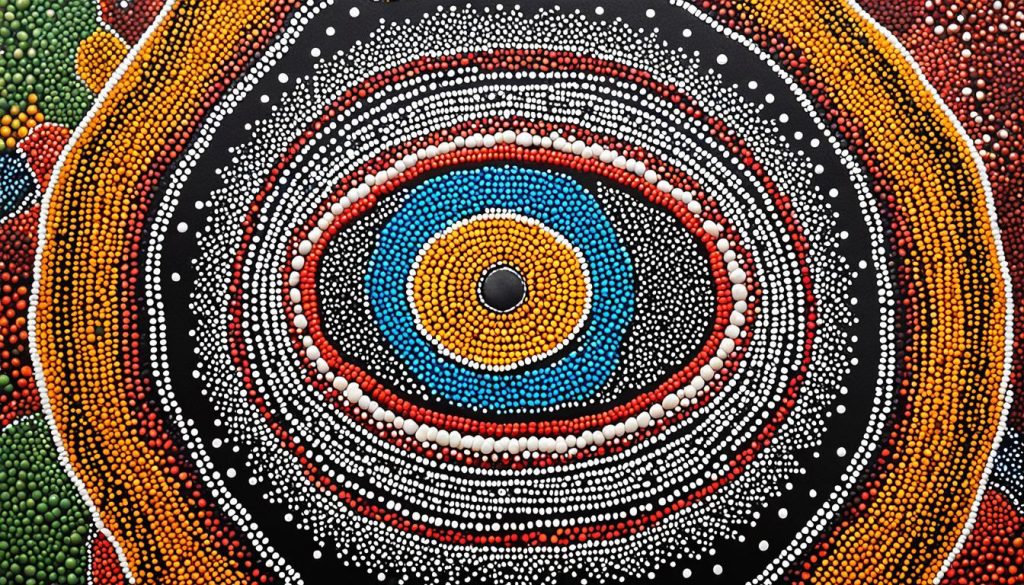
In the coming part, we will show that Western influence did not heavily impact Aboriginal dot painting3. Get ready to discover the true birth of this important art form.
Unbox your creativity, From Beginner to Master: We Have You Covered
Debunking The Western Influence Misconception
In the 1970s, dot painting in Aboriginal art started gaining notice. Many thought it was due to Western influences, like a teacher named Geoffrey Bardon. Bardon did introduce these works to a larger audience. However, dot painting is not a Western creation. It’s an ancient art form adapted by Aboriginal people that already existed for centuries.
Dot painting carries a lot of history and meaning in Aboriginal art. It started long before Bardon got involved. It comes from techniques used in ceremonies by Indigenous Australians5. These paintings hold deep symbolism, showing the bond between people, their land, and spiritual beliefs.
Some mistakenly believe dot painting is a new art. This shows a lack of appreciation for the deep cultural roots of Aboriginal art forms. The truth is, these traditions have been carried on for thousands of years. They tell stories, keep customs alive, and hold spiritual meanings.
Experts point out that Aboriginals have used dot painting for over thousands of years, mainly in ceremonies. This contradicts the idea that it all started in 19715.
Aboriginal art, especially dot painting, is a key part of Indigenous Australian culture. It serves as a way to share traditions, stories, and the importance of the land. This type of art is proof of the strength and imagination of Aboriginal communities. It shows their lasting cultural heritage.
By shedding light on the truth about dot painting’s origins, we value Aboriginal arts and culture even more. It highlights the importance of Aboriginal art in keeping their traditions and culture alive.
Art in the Aboriginal Rights Movement
In the 1960s and 1970s, Aboriginal dot painting found a new use. It became a way for Aboriginal people to express their politics, rights, identity, and connection to their land.
Dots and patterns in the paintings told stories of resistance and cultural pride. Aboriginal artists highlighted their heritage and fought back against the government’s assimilation. This art showed the world their ongoing fight for rights.
Aboriginal artists used dot paintings to share their lives beyond words. This art celebrated their culture and demanded to be seen. It was a way to call for justice and recognition of their community.
By making eye-catching art, Aboriginal artists shared their deep connection with the land. Through their work, they showed a community that was proud and strong. They aimed to keep their traditions alive and stand for equality.
Dot paintings brought people together in the quest for Aboriginal rights. They gained support from both Aboriginal and non-Aboriginal communities. This art became a symbol of defiance, strength, and cultural pride. It reflected the people’s fight for their rights.
The impact of Aboriginal dot painting in the rights movement is still felt today. It encourages, informs, and challenges today’s power structures. Through their art, Aboriginal artists spotlight their community’s stories and demands for justice and respect.
Unbox your creativity, From Beginner to Master: We Have You Covered
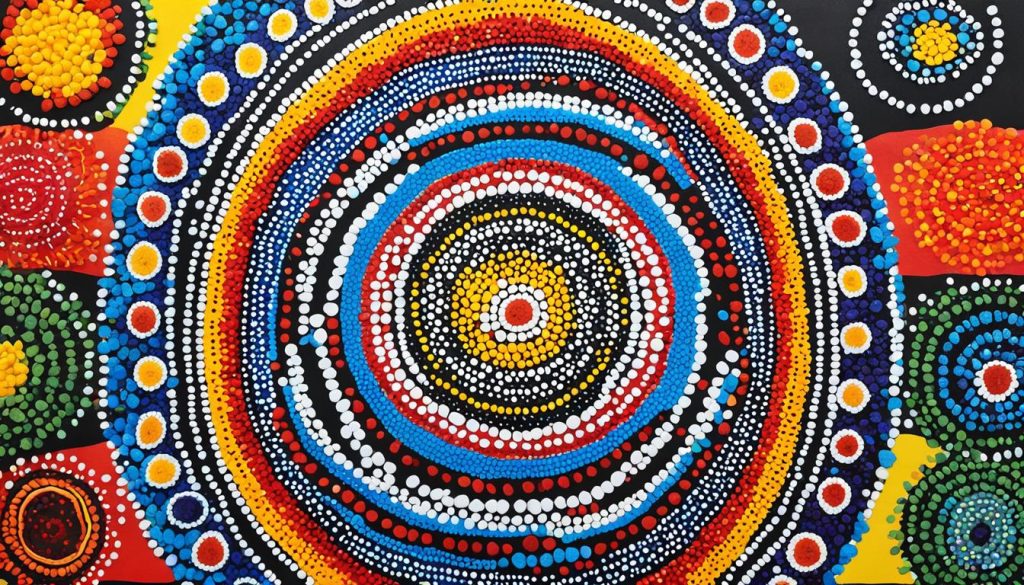
Evolution into the Contemporary Era
Aboriginal dot painting moved from old methods to new ones like canvas, bringing a big change. Now, artists can try new things and show their art to more people without losing its roots. Artists have mixed old ways with new ones, making their stories touch people around the world. This change shows how well Aboriginal art can change and still be true today.
In the Central Desert of Australia, the dot painting style became famous pretty quickly. Modern Aboriginal artists are very creative, mixing old and new techniques to create eye-catching art. This kind of art is now a key part of Australian culture. When people think of Aboriginal art, they often think of dot paintings.
Dot painting’s value goes beyond just being beautiful; it helps keep Aboriginal culture strong. These paintings tell stories and keep important traditions alive. Different communities use dot painting to show their unique histories. It’s a way for Aboriginal people to share their culture with the world.
“The dot painting movement, born out of ancestral traditions, has evolved into a global phenomenon that bridges the gap between ancient traditions and contemporary art.”
Aboriginal Dot paintings come in Ochre and Acrylic forms, with more artists using Acrylics. The dots can be very small or very large. Helen McCarthy Tyalmuty and artists from the Bulgul region are known for their detailed work. Tjapaltjarri creates art that looks like it’s moving.
Dot painting is still very popular today and varies in style, technique, and topic. Some older artists have a more fluid style, but their work is still beautiful. This shows how Aboriginal art’s tradition is alive and changing.
“The dynamic evolution of Aboriginal dot painting has ensured its survival as a prominent art form, wherein both traditional and contemporary artists contribute to its ongoing legacy.”
figcaption: Dot Painting Techniques
Economic and Cultural Impact
Aboriginal dot painting has become popular worldwide. It’s not just art; it’s a way for Aboriginal communities to keep their culture alive. These communities also make money through selling their art. So, it’s about both culture and economics.
This type of painting lets artists make a living. It has also helped the world understand and value Aboriginal traditions. This change in view has led to the growth of these communities.1
People all over the world love and share Aboriginal dot paintings. Works like Emily Kame Kngwarreye’s “Earth’s Creation” are famous. They’ve been in big shows and sold for a lot. This shows how much people want these paintings.1
But it’s not just the artists who benefit. The whole industry is worth a lot of money, up to half a billion dollars. This money goes back into the economy through different areas like tourism and selling paintings. It helps not just the artists, but many other people too.7
Still, there are issues. Sometimes, people copy or use this art without respecting its true meaning. This can harm the cultural value of Aboriginal dot painting. Yet, it’s also a chance to teach and share true Aboriginal culture with the world.17
Aboriginal dot painting is strong and keeps thriving. It shows the world the beauty and strength of Aboriginal culture. It brings everyone together, celebrating and respecting Aboriginal ways worldwide.1
Unbox your creativity, From Beginner to Master: We Have You Covered
Challenges and Opportunities Ahead
Aboriginal dot painting is facing several challenges in the art world today. Issues like appropriation and commercialization threaten its cultural integrity1. The media has shined a light on the authenticity of some works, leading to accusations against well-known artists8. It’s crucial to keep the cultural significance of Aboriginal dot painting alive in a fast-paced global art scene.
Despite these challenges, they also open doors for learning and sharing culture. Understanding Aboriginal art, history, and values can lead to real respect and admiration1. It’s important to have open conversations between Aboriginal artists, dealers, and art lovers. This teamwork can address issues and show the true beauty of Aboriginal culture in these paintings.
Aboriginal dot painting is a powerful form of storytelling and cultural preservation. The paintings use symbols to share important stories and events. This way, the next generation can feel a connection to their culture1. By supporting Aboriginal artists, we keep their stories and traditions alive for the future.
“The inappropriate appropriation of dot painting style robs it of its Aboriginal cultural significance and identity.”9
There’s a bright side for Aboriginal communities in the art’s success. Art centers have become key players in the local economy. They offer jobs that support culture and tradition1. By valuing real Aboriginal artworks, we help these communities grow stronger economically.
To face these issues, everyone must work together with respect and understanding. This means appreciating the true cultural value of Aboriginal dot painting. Doing so makes the art world more welcoming and truly recognizes its cultural importance1.
| Opportunities | Challenges |
|---|---|
| Educational programs and cultural exchanges | Appropriation and commercialization |
| Collaboration between artists and the wider art community | Authenticity and integrity |
| Preserving cultural heritage and stories | Protecting sacred symbols and knowledge |
| Economic empowerment of Indigenous communities | Maintaining cultural integrity |
Embracing challenges and opportunities can help Aboriginal dot painting thrive. It will continue to celebrate culture, preserve tradition, and tell inspiring stories for the future1.
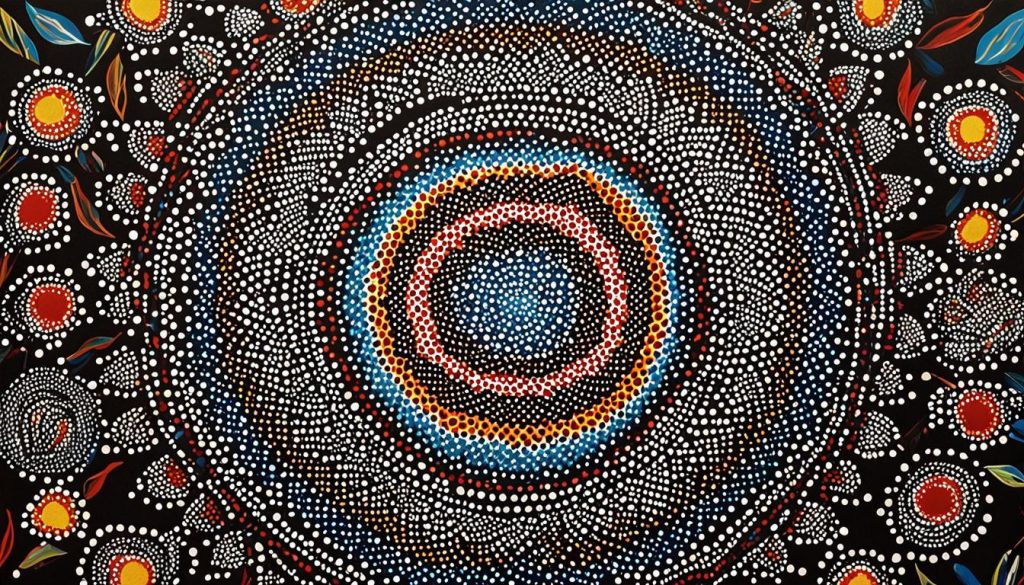
The Future of Aboriginal Dot Painting
Aboriginal dot painting tells a timeless story of Aboriginal people’s creativity and resilience. It shares their culture by showing their survival and identity. The future looks promising for this unique art form.
“Aboriginal dot painting is a living tradition that has crossed generations. It educates and deepens our understanding of Aboriginal culture. It will keep evolving and gaining global attention, safeguarding Aboriginal peoples’ rich stories.”
Looking into the future of dot painting means understanding its deep roots. Aboriginal Australians have a culture that’s among the oldest, dating back thousands of years1. Places like Walinynga (Cave Hill) show Aboriginal presence for at least 24,000 years1. This shows the art form’s development and its continued importance.
Dot painting is deeply connected to ancestors and represents Indigenous Australian stories. Each symbol and dot holds a meaning, reflecting stories of the Dreamtime. These paintings bridge the past, present, and future, keeping the stories alive.
Recently, dot painting has gained global attention, with many artworks selling for millions110. This shows the growing value and cultural importance of these paintings. They are becoming more appreciated worldwide.
Aboriginal art sales support remote communities economically10. This support is crucial for these families and communities. It shows how the art is vital for both the artists and their communities.
As more people get interested, protecting the culture’s authenticity is key. It’s important to prevent misuse and respect the artists’ control over their work. This ensures the paintings continue to be true expressions of Aboriginal culture.
Despite challenges, the future of Aboriginal dot painting looks bright. It will keep sharing stories worldwide, with its vibrant colors and meaningful themes. Dot painting is not just art; it’s a living testament to the Aboriginal people’s strength and culture.
Unbox your creativity, From Beginner to Master: We Have You Covered
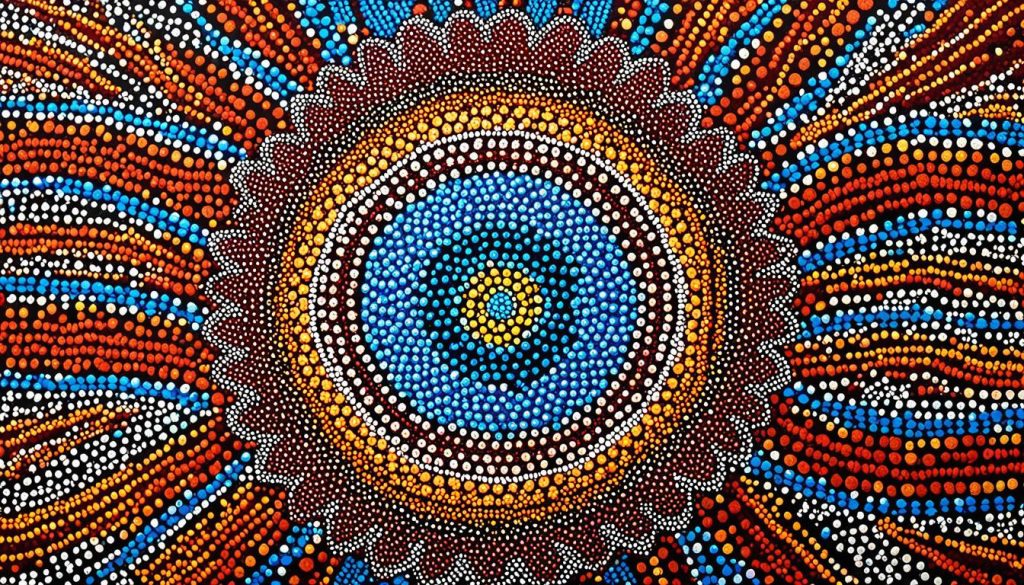
Evolution of Aboriginal Dot Painting Techniques
| Time Period | Techniques | Key Developments |
|---|---|---|
| Traditional Era | Rock, body, and bark painting | Use of natural materials like rock to create sacred images |
| Transition Era | Watercolor painting on small tree bark | Aboriginal artists used watercolors to recreate their designs |
| Contemporary Era | Dot painting on canvas and more | Using dots to blend sacred symbols and allow for wider visibility |
- Aboriginal Australians have one of the oldest continuous cultures in the world, dating back thousands of years1.
- Dot painting techniques have evolved throughout history, adapting to changing mediums and expanding cultural influence10.
- The future of Aboriginal dot painting lies in preserving its cultural integrity while embracing opportunities for global recognition and appreciation10.
Aboriginal Dot Painting: A Global Icon of Cultural Resilience
Aboriginal dot painting is more than just art. It tells stories from thousands of years ago. These stories show how the Aboriginal people have kept their culture strong, even during hard times. Now, it inspires people all over the world.
It offers a glimpse into the rich history and beliefs of Aboriginal groups11. Dot paintings, in particular, reveal deep stories. Indigenous folks use these paintings to share their thoughts. They mix old and new ideas11. For example, Māori art from New Zealand includes special carvings and tattoos11.
The roots of Aboriginal dot painting go back to ancient times. It aims to keep old stories alive. Each dot and symbol in a painting has a special meaning. They talk about Aboriginal beliefs and values. These paintings connect people to their ancestors and the land1.
In the 1970s, dot painting changed a lot thanks to Geoffrey Bardon, a teacher. He helped traditional artists bring their symbols to modern surfaces1. This shift was a big step in the art’s growth. It made Aboriginal art known around the world1.
Aboriginal dot painting isn’t just about looks. It’s a living part of culture and history. Those who truly understand it see its depth. Today, it’s helping Aboriginal communities in many ways. It supports them economically and culturally1.
The future of Aboriginal dot painting looks very promising. It will keep being a strong voice for its people. This art shows the world the resilience and beauty of Aboriginal culture1.
Unbox your creativity, From Beginner to Master: We Have You Covered
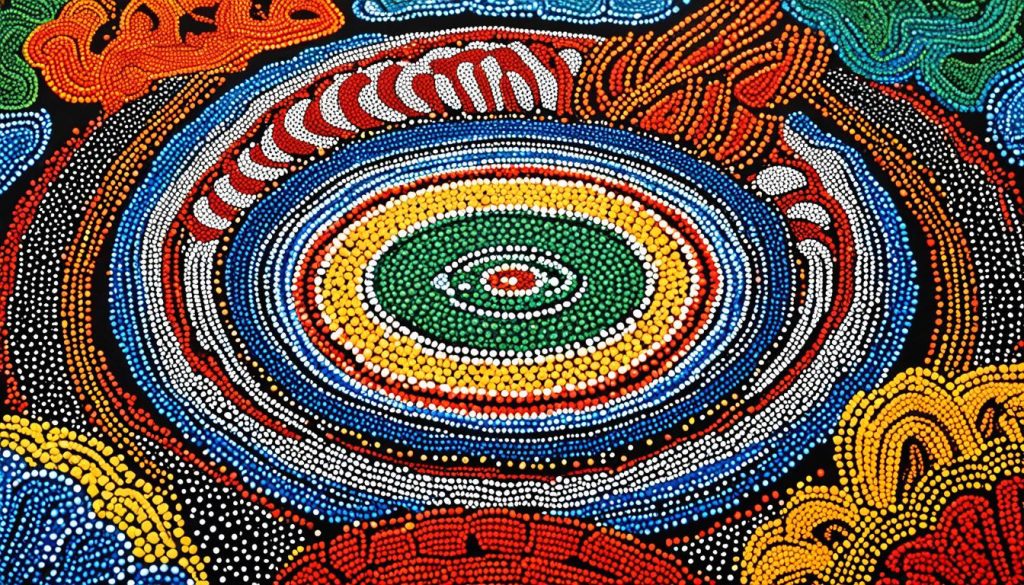
| Key Features of Aboriginal Dot Painting | Examples |
|---|---|
| Deep cultural symbolism | The use of dots and symbols to represent ancestral stories and spiritual connections |
| Colorful and intricate designs | Artworks showcasing vibrant colors and intricate dot patterns |
| Connection to the land | Depictions of landscapes and sacred sites, highlighting the deep spiritual connection to the land |
| Continuity and traditional techniques | Adherence to traditional painting methods and the passing down of knowledge from generation to generation |
Bringing Aboriginal Dot Painting Into Your Space
Do you want a piece of Australia’s rich culture in your home? Consider our authentic Aboriginal dot paintings. These come from the heart of Central Australia. They display the stunning diversity of Aboriginal art.
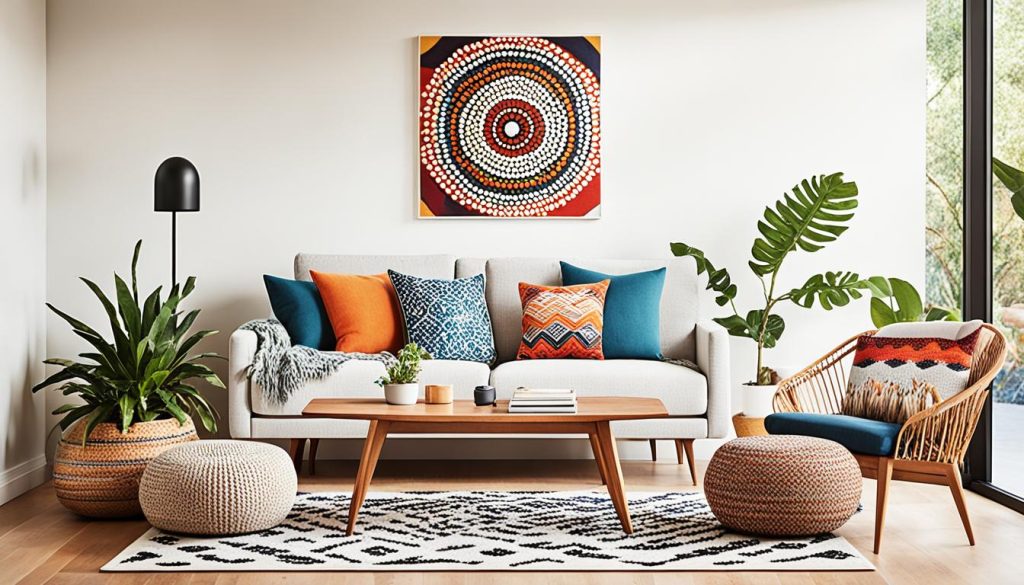
Aboriginal dot paintings are more than just beautiful. They represent the oldest culture’s vibrant stories. Each piece carries deep meaning, perfect for adding cultural value to your space.
Aboriginal dot painting emerged as an evolution of an age-old artistic tradition rooted in one of the world’s oldest continuous cultures1.
Dot painting is a window into Aboriginal spirituality and culture. The dots and symbols in each painting tell ancient stories. This links you directly to Aboriginal mythology and the Dreamtime.
Integrating a dot painting in your home celebrates Aboriginal art’s richness. It showcases the broad range of themes, techniques, and styles of Aboriginal artists. This makes them a treasure for any art lover.
Having Aboriginal art in your space might also make you feel good. It’s been shown to increase happy chemicals in your brain. Plus, the stories behind each painting can help you understand and enjoy it more.
Choose dot paintings with care to suit each room’s look. They can be a statement in the living room, bring calm to the bedroom, or start conversations in the dining area. There are many styles and sizes to pick from.
Unbox your creativity, From Beginner to Master: We Have You Covered
By adding Aboriginal dot paintings, you help both the artists and their communities. Art centers support cultural preservation and offer economic opportunities. This way, artists can share their heritage and make a living.
Conclusion
Aboriginal dot painting is a powerful symbol of cultural strength and artistry from Indigenous Australians. Each dot tells a history, shares a symbol, or a story, showing the heart of Aboriginal culture. This art tradition began thousands of years ago in the oldest parts of the Walinynga (Cave Hill) site1. It remains a beloved art form worldwide.
This unique art style has changed and grown over the years, mixing with new ways and tools. It all started in 19712, thanks to the Papunya Tula Art Movement. At first, they painted strong images of important items and spiritual events. Now, these have turned into detailed dot paintings we admire.
Aboriginal dot paintings are like maps of their culture, showing camps, waterways, paths, and spirits. Journeys and connections to the land are expressed through these paintings. Special signs like U-shaped lines and hand shapes pass down stories from generation to generation. Renowned artists include Ningura Napurula, Marlene Young, and Gabriella Possum for their unique dot painting skills12.
These paintings are not just art, but they also help boost the economy and support communities. In Aboriginal areas, art centers have become important. They keep culture alive and help people earn a living, all while dealing with issues like copying and being turned into mere goods. Yet, they stand strong, holding onto their true cultural spirit even in a worldwide art scene1.
Unbox your creativity, From Beginner to Master: We Have You Covered
FAQ
What is Aboriginal dot painting?
What is the origin of Aboriginal dot painting?
What do the symbols in Aboriginal dot paintings represent?
How does Aboriginal dot painting preserve cultural knowledge?
Why are dots used in Aboriginal dot paintings?
Is Aboriginal dot painting influenced by the West?
What role did Aboriginal dot painting play in the civil rights movements?
How has Aboriginal dot painting evolved in the contemporary era?
What is the economic and cultural impact of Aboriginal dot painting?
What challenges does Aboriginal dot painting face?
What does the future hold for Aboriginal dot painting?
What is the significance of Aboriginal dot painting?
How can I bring Aboriginal dot painting into my space?
Source Links
- https://artark.com.au/pages/aboriginal-dot-painting-evolution-and-history
- https://www.aboriginal-art-australia.com/aboriginal-art-library/aboriginal-dot-art-behind-the-dots/
- https://japingkaaboriginalart.com/articles/aboriginal-dot-painting/
- https://www.kateowengallery.com/page/About-Australian-Aboriginal-Art
- https://www.aap.com.au/factcheck/attack-on-indigenous-culture-fails-to-connect-historical-dots/
- https://www.kateowengallery.com/page/Aboriginal-Dot-Painting
- https://www.aph.gov.au/Parliamentary_Business/Committees/Senate/Environment_and_Communications/Completed_inquiries/2004-07/indigenousarts/report/c03
- https://www.obs-traffic.museum/sites/default/files/ressources/files/Alder_Challenges_to_Authenticity.pdf
- https://www.themaryword.com/post/exploitation-of-aboriginal-artists-and-artworks-needs-to-stop
- https://www.aboriginal-art-australia.com/aboriginal-art-library/the-story-of-aboriginal-art/
- https://blog.daisie.com/indigenous-art-balancing-tradition-contemporary/
- https://mandelartgallery.com.au/blogs/mandel-art-gallery-blog/history-of-aboriginal-dot-painting





